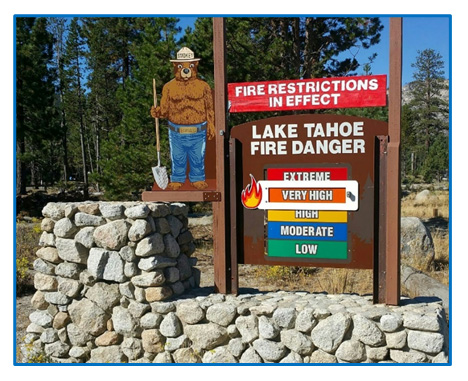Red Flag Warnings and National Fire Danger Rating System

Contact: Eric Guevin, Tahoe Douglas Fire Protection District 775-588-3591 or Lisa Herron, USDA Forest Service Lake Tahoe Basin Management Unit 530-721-3898
LAKE TAHOE, Calif./Nev., July 21, 2022 – Fire season is year-round. In the past, wildfires normally occurred in late summer and early fall when temperatures were high, humidity was low and vegetation extremely dry. Local, state, and federal fire managers now know that devastating wildfires can occur any time of year. Over 90 percent of wildfires are caused by people and are completely preventable. Fire prevention education is the key to keeping our communities and forests safe from unwanted wildland fires.
Lake Tahoe Basin, California and Nevada fire restrictions are implemented by fire and land management agencies to help keep our communities and forests safe during conditions that lead to increased wildfire danger. In addition, the National Weather Service (NWS) issues Red Flag Warnings and Fire Weather Watches to alert fire departments, fire districts, and the public about critical fire weather conditions that have the potential to cause wildfires to grow rapidly in size and intensity before first responders can contain them. The NWS issues Red Flag Warnings when strong gusty winds combine with very dry air, or when thunderstorms with little to no rainfall are expected. Below is an explanation of the differences between a Fire Weather Watch and a Red Flag Warning.
- Fire Weather Watch - declared when critical fire weather conditions could develop over the next 2-4 days. A watch is issued when forecasters have reasonable confidence that critical conditions will develop at longer lead times.
- Red Flag Warning - declared for weather events which may result in critical fire weather conditions that may occur within the next 24-48 hours. A Red Flag Warning is the highest alert. During these conditions, extreme caution is urged because a simple spark can cause a major wildfire.
During Red Flag conditions in the Lake Tahoe Basin, all open flames including propane are banned to prevent major wildfires from happening.
In addition to Red Flag Warnings and Fire Weather Watches, the National Fire Danger Rating System (NFDRS) allows fire managers to estimate the daily fire danger for a given area. NFDRS uses five different color-coded adjective ratings to help the public understand fire potential. These signs are placed in key locations to alert the public about current fire danger and are most often associated with roadside Smokey Bear signs. Below is an explanation of the different fire danger adjective ratings.
- Fire Danger Level: Low (Green)
Vegetation that can feed a wildfire does not ignite easily from small embers, but a more intense heat source, such as lightning, may start fires in duff or dry rotten wood. Fires in open, dry grasslands may burn easily, but most wood fires will spread slowly, creeping or smoldering. Control of fires is generally easy.
- Fire Danger Level: Moderate (Blue)
Fires can start from most accidental causes, but the number of fire starts is typically low. If a fire starts in an open, dry grassland, it will burn and spread quickly on windy days. Most wood fires will spread slowly to moderately. Average fire intensity will be moderate except in heavy concentrations of vegetation, which may burn hot. Fires are still not likely to become serious and are often easy to control.
- Fire Danger Level: High (Yellow)
Fires can start easily from most causes and small vegetation (such as grasses and needles) will ignite readily. Unattended campfires and brush fires are likely to escape. Fires will spread easily, with some areas of high intensity burning on slopes or concentrated vegetation. Fires can become serious and difficult to control unless they are put out while small.
- Fire Danger Level: Very High (Orange)
Fires will start easily from most causes. The fires will spread rapidly and have a quick increase in intensity, right after ignition. Small fires can quickly become large fires and exhibit extreme fire behavior, such as long-distance spotting and fire whorls. These fires can be difficult to control and will often become much larger and longer-lasting fires.
- Fire Danger Level: Extreme (Red)
Fires of all types start quickly and burn intensely. All fires are potentially serious and can spread very quickly with intense burning. Small fires become big fires much faster than at the "very high" level. Spot fires are probable, with long-distance spotting likely. These fires are very difficult to fight and may become very dangerous and often last for several days, weeks or months.
It's vital that everyone in the Lake Tahoe Basin educates themselves about wildfire prevention and preparedness. Share learned information with family and friends, and always take steps to prevent a wildfire from sparking. Together, we can prevent the next wildfire. For links to Red Flag Warnings and Fire Danger Ratings, and tips for preventing and learning to live with wildfire, visit TahoeLivingWithFire.

###